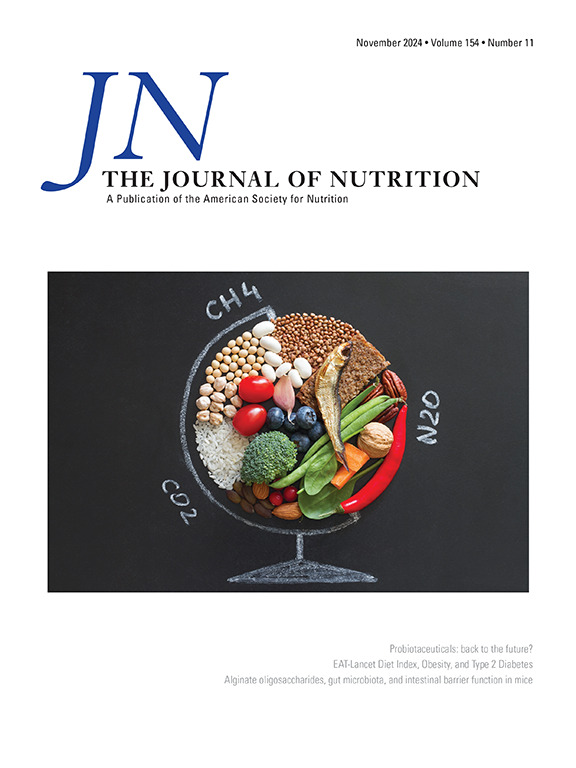Acute Effects of an Anthocyanin-Rich Blackcurrant Beverage on Markers of Cardiovascular Disease Risk in Healthy Adults: A Randomized, Double-Blind, Placebo-Controlled, Crossover Trial
IF 3.8
3区 医学
Q2 NUTRITION & DIETETICS
引用次数: 0
Abstract
Background
Epidemiologic evidence suggests an inverse association between anthocyanin consumption and cardiovascular disease (CVD) risk. Modulation of vascular function and hemostasis may contribute to this, but there is limited clinical evidence.
Objectives
The present study investigated the acute effects of an anthocyanin-rich blackcurrant beverage, compared with a matched placebo, on selected markers of CVD risk in healthy middle-aged subjects in response to a high-fat meal.
Methods
Twenty-three volunteers aged 39.9 ± 8.1 y [body mass index (BMI) (in kg/m2) 22.9 ± 2.3] completed a double-blind, randomized, placebo-controlled, crossover trial. Volunteers consumed either a 200 mL blackcurrant beverage (744 mg polyphenols comprising 711 mg anthocyanins and 32 mg procyanidins) or a placebo, together with a high-fat breakfast (52.3 g fat) followed by a lunch (30 g fat) at 3 h, and the postprandial vascular response was compared. The primary endpoints were the assessment of vascular function by flow-mediated dilation (FMD) and the inhibition of collagen- and adenosine diphosphate-induced platelet aggregation. Secondary outcomes included blood pressure (BP), digital volume pulse waveforms, circulating numbers of endothelium- and platelet-derived extracellular vesicles, plasma concentrations of interleukin (IL)-8, and plasma and urinary concentrations of polyphenols and their metabolites were also evaluated.
Results
There was a significant cumulative improvement in FMD following consumption of an anthocyanin-rich blackcurrant beverage compared with a matched placebo in conjunction with a high-fat meal over a 6 h postprandial period. There was a trend for an inhibitory effect of the blackcurrant beverage on agonist-induced platelet aggregation and significant effects on the secondary outcomes, systolic BP and IL-8, although these were exploratory and not adjusted for multiple testing. Plasma concentrations of hippuric acid and isovanillic acid were strong independent predictors of FMD, and 4-hydroxybenzaldehyde and isoferulic acid glucuronide were predictors of systolic BP and diastolic BP.
Conclusions
An anthocyanin-rich blackcurrant beverage mitigates the effects of a high-fat meal on vascular function and markers of CVD risk, and this is associated with the appearance of specific plasma anthocyanin phenolic metabolites.
This trial was registered at classic.clinicaltrials.gov as NCT02459756.
一种富含花青素的黑加仑饮料对健康成人心血管疾病风险标志物的急性影响:一项随机、双盲、安慰剂对照的交叉试验
背景:流行病学证据表明花青素摄入与心血管疾病(CVD)风险呈负相关。血管功能和止血的调节可能与此有关,但临床证据有限。目的:本研究调查了一种富含花青素的黑加仑饮料,与一种匹配的安慰剂相比,对健康中年受试者在高脂肪饮食后心血管疾病风险的选定标志物的急性影响。方法:23名年龄39.9±8.1岁(BMI 22.9±2.3 kg/m2)的志愿者完成了一项双盲、随机、安慰剂对照、交叉试验。志愿者饮用200毫升黑加仑饮料(744毫克多酚,包括711毫克花青素和32毫克原花青素)或安慰剂,并在3小时内吃高脂肪早餐(52.3克脂肪)和午餐(30克脂肪),并比较餐后血管反应。主要终点是通过血流介导扩张(FMD)评估血管功能,以及抑制胶原蛋白和二磷酸腺苷诱导的血小板聚集。次要结果包括血压(BP)、数字体积脉冲波形、内皮和血小板来源的细胞外囊泡(ev)循环数量、血浆白细胞介素(IL)-8浓度、血浆和尿液多酚及其代谢物浓度。结果:在餐后6小时内,食用富含花青素的黑加仑饮料后,与服用安慰剂并食用高脂肪食物相比,口蹄疫的累积改善显著。黑加仑饮料对激动剂诱导的血小板聚集有抑制作用,对次要结果收缩压和IL-8有显著影响,尽管这些都是探索性的,没有经过多次测试调整。马尿酸和异香草酸的血药浓度是口蹄疫的独立预测指标,4-羟基苯甲醛和异香草酸葡萄糖醛酸是舒张压和舒张压的预测指标。结论:富含花青素的黑加仑饮料减轻了高脂肪膳食对血管功能和心血管疾病风险标志物的影响,这与特定血浆花青素酚代谢物的出现有关。注册地址:https://classic.Clinicaltrials: gov/ct2/show/NCT02459756;唯一标识符:NCT02459756。
本文章由计算机程序翻译,如有差异,请以英文原文为准。
求助全文
约1分钟内获得全文
求助全文
来源期刊

Journal of Nutrition
医学-营养学
CiteScore
7.60
自引率
4.80%
发文量
260
审稿时长
39 days
期刊介绍:
The Journal of Nutrition (JN/J Nutr) publishes peer-reviewed original research papers covering all aspects of experimental nutrition in humans and other animal species; special articles such as reviews and biographies of prominent nutrition scientists; and issues, opinions, and commentaries on controversial issues in nutrition. Supplements are frequently published to provide extended discussion of topics of special interest.
 求助内容:
求助内容: 应助结果提醒方式:
应助结果提醒方式:


